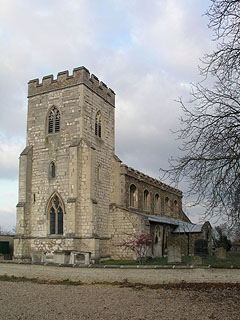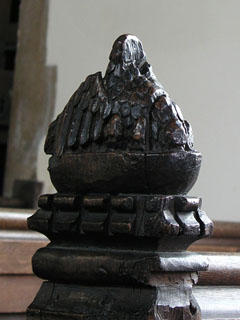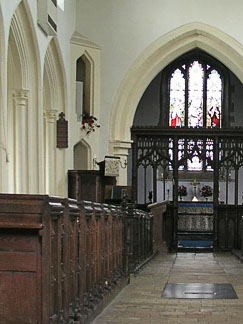St Mary sits on high ground to the south of the village, abandoned when the population moved north to take advantage of the increased trade along the Cambridge-Sandy road in the 17th century. Bereft of its village, with only a few grand old houses for company, the church stares out over the fields. I first saw it on a sunny November day. I had visited Madingley just previously, and cycling from there had reminded me that not all of Cambridgeshire is as flat as the fens. I had also managed to rip my trousers, so I was feeling a little irritated with the world at large, and little inclined to be charitable to the church that had dragged me half a mile south out of its village up a big hill.
Still, it piqued my interest immediately, and then pricked (as you might say) my pique. The 14th century tower has been restored in places, and the combination of weathered and new blocks of whitish stone gives it a slightly leprous look. The nave, though, is very interesting - built in golden-brown fieldstones, with a clerestory that has bigger windows than the aisles. Intrigued, I entered. The first thing that struck me was the Perpendicular nave arcade on the north side - the piers are lozenge shaped with half-pillars on the inner edges, and the arches themselves are very flat and Tudor looking. The clerestory is from the same period; the south arcade is a more normal Early English design with octagonal piers.
The nave has quite a large number of 15th century benches. These obviously all had figures on the ends at one point, though most of them have now been hacked off. A few things remain - in the central aisle there is a poppy-head that has a shield on one side and what looks like two men fighting on the other.
My favourite was at the east end of the north aisle - there is a hen (now headless) sitting on her brood, whose hungry heads reach up imploringly around the base.
There must have been a lot of magnificent woodwork in this church at one point. The panels on the fronts and sides of the original benches are finely carved with blind arcading, and there is a large amount of the same panelling placed around the walls end of the north aisle, now used as the lady chapel. The screen is also from the 15th century, though it has been moved and the end two bays have been lopped off to make it fit in the chancel arch. Judging from the position of the rood stair, it must have stood a little way in front of the arch, and it must have had a magnificent superstructure. In the chancel (otherwise rather dark and boring, and possessed of some truly horrid glass) some of the choir stalls incorporate original work, including a poppy-head with two half-angels.
A mystery: in the east end of the nave, just next to where the rood screen must have reached the south arcade, there is a little carved head in the wall. It smiles enigmatically at us, and well it might - I can't imagine what it is, or what it signifies.
When I returned with Mark a few days later, we found that the door into the tower stair was open. Like several churches in this area, the staircase is inside the tower, rather than in a turret on the outside. We went up a way and emerged into a chamber which has been laid out as a little museum. There are displays giving information about the parish and laying out some bits of old metalwork that have been uncovered in the soil. The chamber was refurbished using money from the Millennium fund, principally so that people can come up and see the wooden bell-frame. It is a magnificent structure, the oak beams criss-crossing the dark space above us. The ladder up there is locked using a board attached to the lower reaches, but I was able to scramble over that and clamber up into the midst of the bells themselves. They sat, quiet and huge, ancient metal held in place by ancient oak. I was reminded of what Lord Peter Wimsey says in Dorothy L. Sayer's The Nine Taylors - "Bells, like mirrors and cats, are queer things, and it doesn't do to think much about them."
St Mary was open both times I've visited


